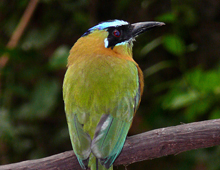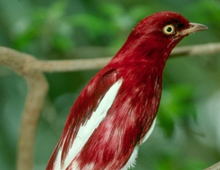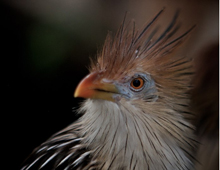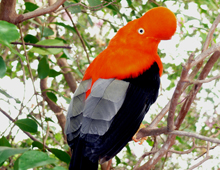The Lek

Blue-crowned motmot, Momotus momota
Found from Mexico to Argentina, this brilliantly-colored kingfisher relative is the only one of the nine members of the Tropical American motmot family to be widely kept in zoos, where many have bred. Eggs are laid in burrows dug in the earth. The remarkable pendulum-like tail develops normally at first, but parts of two feathers are shed as they develop, resulting in “racquets”. The strange name may be derived from this bird’s whooping calls.
LEARN MORE
Troupial, Icterus icterus
The National Bird of Venezuela, this South American oriole has been a prized cage bird for more than 150 years. The painter, Henri Mattise, included one in his collection of tropical birds that he kept to “tune his colors”. They are sometimes known as “Bugle Birds” for their piercing, melodious voices. Chicks have hatched at the DWA.
LEARN MORE
Pompadour cotinga, Xipholena punicea
Depending on the light, males may appear black, bright red, pink, or purple. Research conducted at Yale University’s Peabody Museum of Natural History, with the assistance of the DWA, has established that this species’ color is due to unique carotenoid pigments previously unknown in birds.
LEARN MORE
Guira cuckoo, Guira guira
Before the 1990s, this small Southern South American relative of the roadrunner was rare in captivity. In the last 15 years, many have been bred in US zoos. Zoo-bred specimens, like all the Guiras at the DWA, can be delightfully tame. Some may follow visitors as they walk through the Orinoco.
LEARN MORE
Andean cock-of-the-Rock, Rupicola peruvianus
Every year since 2007, this remarkable bird has reproduced at the DWA. Through May 2011, 40 had hatched here, with 26 surviving to independence. Prior to this time, the total number successfully reared in US zoos were four at Houston and one at San Diego, with the last hatching occurring in 1989. Offspring from the DWA have been sent around the world, and the first second generation breedings took place at the San Diego Zoo in 2011, with males from Dallas. While performing their courtship display, males make buzzing shrieks that can be heard throughout the Orinoco. Nesting takes place in specially built artificial caves.
LEARN MORE

